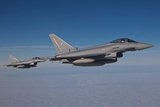Link 16 Breaks New Ground (sponsored whitepaper)
This whitepaper is brought to you by Viasat
Rethinking the Link 16 Environment with the Introduction of the Next-Generation of Terminals
INTRODUCTION
Link 16 has evolved as the modern battlefield needs have changed, first from coordinating Cold War air intercept missions to helping U.S. and allied forces maneuver in today’s often complex operating environment.
Since its development in the 1970s, Link 16 has become the most widely used, secure, jam-resistant line-of-sight waveform and continues to serve as the tactical data link of choice for air-to-air warfare. With over 40 countries now leveraging the nearly worldwide presence of Link 16, it is anticipated that the number of Link 16-enabled platforms will exceed 15,000 by 2020. In a study by the RAND Corporation, it found that Link 16 implementation drove a 2.5 times improvement in the kill ratio (red aircraft to blue aircraft shot down), during both daylight and night time conditions. Interviews with experienced pilots also revealed that a functioning Link 16 terminal is often considered “go/no go” criteria for missions in a hostile environment.

FIGURE 1. LINK 16 REAL-TIME SITUATIONAL AWARENESS ACROSS THE BATTLEFIELD
In those instances, Link 16 has demonstrated its resilience in multiple ways, delivering a range of key capabilities that include:
- Exchanging secure, jam-resistant communications, including Situational Awareness (SA) data and Command and Control (C2) information in real time
- Sharing digital voice and data, text messages, and, to a limited extent imagery
The air-to-ground domain however, has historically been very different. Voice has been the predominant communications medium up until a few years ago when Variable Message Format (VMF) MIL-STD-6017 messages were adopted as the Digitally-Aided Close Air Support (DaCAS) standard. However even with a concerted effort by the U.S. Department of Defense (US DoD) J6 Deputy Directorate for Command and Control Integration to create standardization across VMF DaCAS requirements, there continues to be longstanding issues with interoperability (such as significant loss of key data and slow refresh rates). Additionally, the use of MIL-STD-6016 TADIL-J messages over the U.S. Army’s Enhanced Position Location Reporting System (EPLRS) with the Situation Awareness Data Link (SADL) for the U.S. Air Force Reserve and Air National Guard has further complicated the process.
This has resulted in deployment of a large number of gateways operating in the battlefield, as the need to converge and translate incompatible messages from disparate networks (VMF, SADL, Link 16, Beyond-Line-of-Sight (BLOS), etc.) into clear and interoperable communications has been a key priority.

FIGURE 2. NEXT-GENERATION OF LINK 16 PRODUCTS
Now with technological innovations in the next-generation of Link 16 terminals, air-to-ground operations are being looked at in an entirely new way and have opened up more and more uses for Link 16. With the majority of our last two decades of air operations now involving air-to-ground actions, a significant focus has been placed on target delivery accuracy, fratricide and collateral damage reduction, and speed of engagement for DaCAS. However, these advancements in technology also require additional thought in terms of leveraging different approaches to the sharing and managing of information among participants in the network, which is what will be addressed in this white paper.
INFORMATION EXCHANGE REQUIREMENTS ARE CHANGING
Today’s Link 16 networks are specifically designed to support theater-wide engagements, with SA, C2, and Information Exchange Requirements (IERs) across the entire theater Area of Operations (AO). Fast flyers share a similar situation, as friendly and enemy positions need to be identified hundreds of miles away and the Link 16 IERs that are used within this domain are specifically for major engagements and include rapid changes in both friendly and hostile positions.
Now with the introduction of low-flying helicopters and ground node Link 16 users, IERs are much more localized in their AO (pre-defined geographic regions that are much smaller than those for high, fast flyers). Compared to a pilot in the air, who can see or communicate with other aircraft up to hundreds of miles away, dismounted ground forces are limited by the curvature of the Earth and the terrain they are in so the distance and speed at which they maneuver also impacts their IERs, including how often their position (called a Precise Participant Location and Identification or PPLI) needs to be updated.

FIGURE 3. MOJO EXPEDITIONARY TACTICAL GATEWAY
One approach to solving the disparity between the differences in IER span has been to deploy gateways across the battlefield – to overcome geography, terrain, and a lack of interoperable communications. Gateways like the Battlefield Airborne Communications Node (BACN) provide broad, theater-wide connectivity enabling situational awareness up to the highest command levels. Mission specific gateways like the Move Out/Jump Off¬ Kit/Tactical Radio Application eXtension (MOJO/TRAX) are designed for more austere operations and being widely deployed to provide the localized connectivity needed for dismounted ground forces, and to bridge the gap between air and ground COP.
NEW FRONTIERS IN NETWORK DESIGN + DEPLOYMENT
Dismounted ground operations are the new frontier for the next-generation of Link 16 systems. Unlike their larger airborne and naval predecessors, these nodes spend more of their time receiving transmissions from other platforms such as aircraft, than transmitting themselves.
One of the challenges for operating in a ground or ground-to-air environment is signal clutter and interference. However, the particular band that is used by Link 16 radios, 969 megahertz to 1215 megahertz, is not cluttered with other battlefield users and is occupied by Civilian Air traffic navigation systems.
The inherent security characteristics of Link 16 can also help with localized IERs. The anti-jamming, frequency hopping patterns used by Link 16 terminals can be selected (called Net Numbers) and used to keep IERs separated. Link 16 supports up to 127 such separate nets. Different cryptographic keys and partitioned variable modes can be used to isolate data, while still allowing for range extending relay. Timeslot reassignment pools can be designed to adapt to usage requirements, while contention pools can be used for an information span that is geographically smaller.
There is also a misperception in some circles that Link 16 networks are oversubscribed. This is often true for the theater-wide net, but there are over a hundred available frequency pattern nets that typically go completely unused. Further, like cellular or satellite communications systems, bandwidth (called Net Numbers) can be divided and shared across a theater. For example, on the ground, a unit can set up a small unit net using a frequency pattern for its communications or Link 16 system. Tens of miles away, another unit can set up its net and do the same thing because they do not interfere with each other. This is one network management option the DoD is examining to help with operations and communications in ground environments.
Another example is highlighted in The MITRE Corporation’s report on Multi-net Operation of JTIDS TDMA. According to the report, there is more than enough bandwidth on the Link 16 waveform for multiple network IERs that are either localized and/or separated from theater-wide level participants. For instance, network enabled weapons are short duration users that only need to communicate with their controlling sources for specific data exchanges, including target updates and status messages. Joint Terminal Attack Controllers only need to exchange data (PPLI) and share targeting information with fighters that are directly in support of their mission. The remaining localized users only need to share information with a few Link 16 participants, such as fire support elements that need to adjust fire with only a few Forward Air Controllers (FAC) or exchange Link 16 voice.
CONCLUSION
The new capabilities that are being delivered by the next-generation of Link 16 terminals, combined with the expansion of Link 16 into new domains, allow Link 16 to be available for integration into new types of platforms and nodes that will be entering service in the coming years. It is this flexibility to meet the changing operational needs of the battlefield that has maintained Link 16’s viability over the last 40 years.
The adoption of Link 16 by so many emerging use cases is not accidental. Instead, it is a reflection of the Link 16 community’s evolving understanding of the modern battlefield – and this will lead to a network that is not only ubiquitous, but also sufficiently robust to support the connectivity that is needed to deliver the more extensive use of enhanced SA in future near-peer conflicts.
However, widespread deployment is only one aspect of ensuring overall mission success. To execute these missions more efficiently in the future, the entire Link 16 ecosystem must be taken into account and extend to all users in the network. This includes not only Link 16 terminal technology, but also the Concept of Operations (CONOPs), IERs, software tools, support equipment, and comprehensive training.
And by packaging the most advanced capabilities for all types of users, the tactical data link, which demonstrated its ability to coordinate air intercept missions during the Cold War, is now directly in the hands of warfighters at the tactical edge.
Learn More here.
More from Modernised Situational Awareness Special Report
-
What is MOJO? (sponsored video)
Viasat’s Move Out/Jump Off terminal allows operational commanders at the tactical edge to receive the best possible levels of situational awareness required to do their job.
-
What is an STT? Small Tactical Terminal (sponsored video)
The KOR-24A STT extends the ability of warfighters to conduct real-time communications and increase interoperability in austere environments.
-
![What is BATS-D? (sponsored video)]()
What is BATS-D? (sponsored video)
BATS-D provides dismounted personnel with a ground-to-air capability to shorten the targeting cycles and accuracy of close air support and other fire missions.
-
![What is MIDS? (sponsored video)]()
What is MIDS? (sponsored video)
Viasat’s Government Systems division provides U.S. and coalition military forces with a range of advanced communications technology. Here’s a quick description of one of them: MIDS
-
![What is Link 16? (sponsored video)]()
What is Link 16? (sponsored video)
Viasat’s Government Systems division provides U.S. and coalition military forces with a range of advanced communications technology. Here’s a quick description of one of them, Link 16:
-
![US augments EW defence with network modernisation]()
US augments EW defence with network modernisation
The US Army is working to modernise its tactical networks to enable expeditionary and mobile operations, and bolster its resilience against near-peer EW and cyber …

























